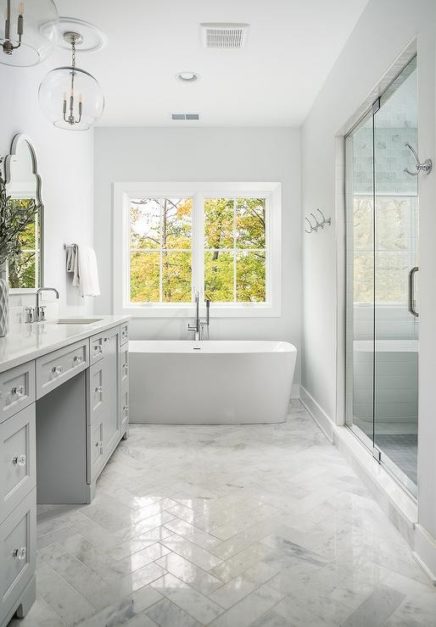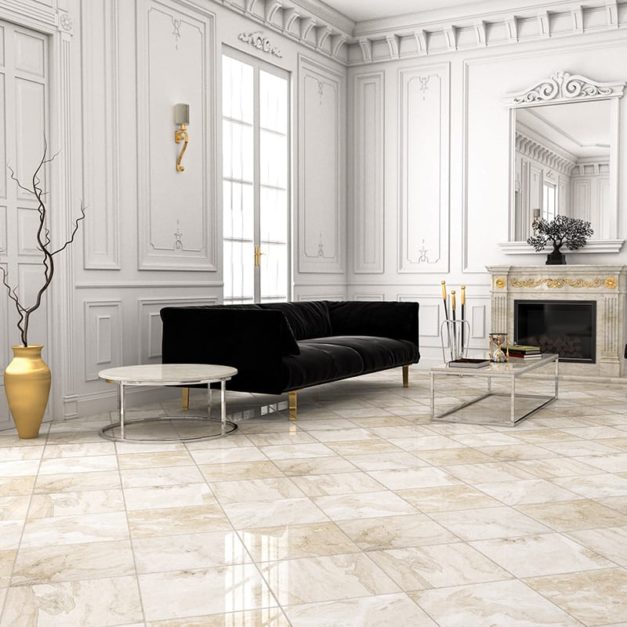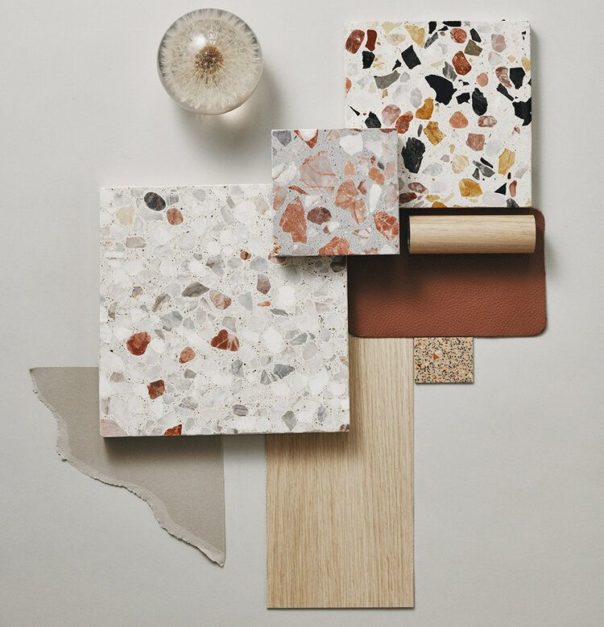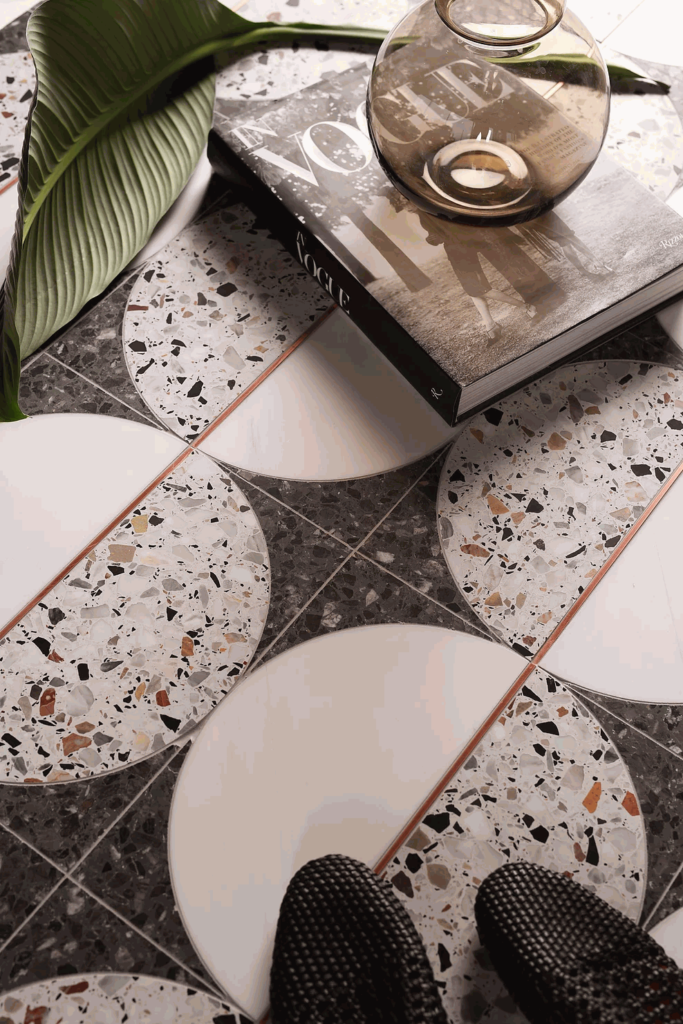If the age-old maxim of ‘buy once, buy well’ is to be followed, one should not hold back in investing in an appropriate flooring option for their space. Whether you are looking for something to fit in a crisp monochrome scheme or a bold contemporary design, the right flooring can serve as an ample background to showpiece the rest of the space. While there are a plethora of choices in terms of finishes and formations, homeowners generally tend to choose either marble or terrazzo flooring.
The best flooring options are those that stand the test of time, in terms of material, durability and maintenance. Whether it is the unique natural markings and colours that trickle through in a marble surface or the texture and individuality of terrazzo tiles, both blend aesthetics with hardwearing functionality. Graana.com, Pakistan’s smartest property portal, describes the pros and cons of both to help you decide and pin down the right flooring.
What Is Marble?

Marble is a natural stone that is made through the metamorphic crystallisation of limestone. The use of marble in architecture dates back to the time of the ancient Greeks and Romans, which gives it its luxury status.
As compared to other plain materials, it can add a layer of texture. You can also incorporate neoclassical designs with marble for a classic yet contemporary look. It adds depth that you can’t typically get in other printed or patterned designs.
Where Can You Use Marble?

Marble can be used in any room as a striking focal feature, either to balance a busy, bright space, or to add a touch of warmth to a cool space. It can also be incorporated in other fittings and fixtures — or even to clad an entire wall — so as to give a cohesive and fluid look to a room, like vanity tops or kitchen backsplashes etc.
Pros of Marble
Whether you want to give a nod to a feature floor or just let the muted colours provide an uplifting and seamless appearance, marble serves as an enduring classic. The following are some of the advantages of using marble in your interior:
Natural Elegance
As it is a natural stone, each tile or slab or marble is unique with different and subtle organic markings. The graphic striations and colours of the stone add a luxe finish to the room. Its natural hues offset any sense of a clinical design; in fact, it creates a quiet and sophisticated backdrop. Unlike most naturally occurring stones, marble can also be polished, which gives it an even smoother look.
Reflects Light
A distinctive feature of marble is that it seems translucent — it enhances the amount of natural light in a room by reflecting it, which makes a space seem brighter and bigger than it actually is. This also brings out the colours of the marble design in a better way.
Excellent Heat Conduction
All stone and ceramic tiles are notoriously cold underfoot. However, marble can serve as a good base for radiant floor heating systems. Paired with in-floor heating, the floor can be comfortable and cosy.
Does Not Accumulate Allergens
Marble does not tend to collect dust or pollen particles, unlike most flooring options. You can easily spot the dust and wipe it away, thus preventing any severe allergies.
Increases Property Value
Even though it comes with a hefty price tag, marble has always been associated with luxury. This increases the value of your place in case you are planning to resell it in the future.
Marble is also able to withstand external pressure, which makes it appropriate for spaces that receive a lot of footfall, like a kitchen or bathroom. This durability also adds to a property’s overall value, as homebuyers prefer interior options that have an extended lifespan.
Versatile
Marble flooring is timeless yet versatile. From bedrooms and living rooms to kitchens and bathrooms, they can be installed in practically any room. Technological advancements have made it more accessible and now a myriad of options are available in the market in terms of colours, patterns and designs. As it is soft in nature, the exact dimensions of the tiles can be cut out and the edges or shapes can be moulded easily. This makes it easily customisable, according to your personal taste and preference.
Cons of Marble
The drawbacks of marble flooring are as follows:
Not Cost-Effective
Marble is generally more expensive than other stones. Since it is made of natural composition, it can be difficult to replace in case of damage, especially since it is practically impossible to find the same veining and pattern in the market. You would have to acquire minimal stock in this case. It can also scratch and chip around the edges fairly easily. If it breaks or if you cannot get rid of deep-set stains, you can not fully restore the marble flooring to its original condition at a cheap cost.
Susceptible to Stains
Marble can stain easily, and regular maintenance and polishing is required so it doesn’t lose its lustre.
The colour of marble can also become yellow over time if it has more iron content.
Marble is also porous in its natural state so it needs to be treated with a sealant to protect against staining. In fact, suppliers advise to reseal marble surfaces up to 4 times a year, which can be costly and inconvenient.
Risk of Slipping
An appropriate flooring for bathrooms should be durable and able to withstand frequent splashes of water. Marble does not fit this criteria; it can become brittle and slippery over time, which actually makes it more dangerous. It can even be slippery after being polished.
What Is Terrazzo?

Derived from the Latin word ‘terra’ (meaning ground), terrazzo is a mixture of aggregates like glass, mother of pearl etc. suspended in cement or concrete. It dates back to the 16th century, when it was commonly used in Italy to reuse stone offcuts. This ancient composite material can add a Mediterranean touch to a room’s design.
Modern designs have also incorporated the use of resin to produce terrazzo. Although a much more expensive option than traditional terrazzo, this gives it a smooth finish and makes it even more resistant to cracks and scratches.
Where Can You Use Terrazzo?

Terrazzo can be installed in any room (for both walls and floors), and also custom surfaces like stairs, countertops etc.
It is also commonly being used in building furniture and homeware nowadays like headboards, lampshades or chairs as it can be prepared by pouring into moulds.
Pros of Terrazzo
Although terrazzo fell out of favour in the design industry a few years ago, it is now making its way back due to the following advantages:
Wide Array of Design Options
With terrazzo, the colour and design possibilities are virtually limitless. It can pack chips of any size, according to your chosen pattern.
This makes it a popular choice for flooring in both indoor and outdoor spaces.
On the other hand, marble is only limited to its natural stone colour and pattern.
Flexible
As precast elements, terrazzo can be made in a factory according to any shape, so you have free reign when it comes to its design.
In contrast, marble is inflexible as it only comes in a few shapes and designs.
Bears a Smaller Carbon Footprint
Since terrazzo is made from recycled material, like pebbles, quartz, marble chips, glass chips etc., it is more environmentally-friendly and sustainable. It is also VOC-free i.e. it has a negligible amount of volatile organic compounds. Hence, this improves the air quality in your surroundings.
However, marble requires a lot of energy to produce. A lot of waste also accumulates in the process as cutting the marble gets complicated when you have to match the exact design pattern in each tile or slab.
Easy to Maintain
Terrazzo is resistant to bacteria and most chemicals. The only upkeep it requires involves just a mop (or a scrubbing brush) and a bucket of warm water.
However, it is important to note that this can vary depending on the type of terrazzo flooring that has been installed. Slabs of terrazzo are easier to maintain than poured terrazzo, in which case you would need to call in a professional to reground and repolish the floor.
It is also non-porous; it is smoothed and sealed to prevent air and liquid from seeping into the tiles, which reduces chances of the growth of mildew or mould.
Durable
Terrazzo also happens to be much stronger than marble as it is made of sturdy materials. The thickness of marble tiles can range from 3/8 inches to 1/2 inches, whereas terrazzo can be as thin as 1/4 inches.
It is estimated that terrazzo can last up to 75 years, with minimal to no repairs.
Affordable
Terrazzo floors can be installed at a fraction of the price of marble floor installation. You can further reduce the cost by swapping out marble chips in the terrazzo composition for another stone, or by opting for terrazzo tiles instead of large slabs.
Cons of Terrazzo
Some of the disadvantages of terrazzo floors have been listed below:
Uncomfortably Cold
Terrazzo floors can be unbearably cold underfoot if carpets or rugs have not been added to the room. This is because it does not have the ability to retain warmth effectively. It is especially unsuitable for places that experience cold weather throughout the year.
Tricky Installation
The installation process can be complicated as professionals need to ensure that all the aggregate materials are mixed correctly and in the right proportion. If any component is too much or too little in quantity, the floor can look inelegant and clumsy.
High Initial Costs
Even though it can last long and is highly stain and scratch resistant, terrazzo can still be expensive. The initial cost of terrazzo per square foot is higher in comparison to other materials.
Marble or Terrazzo: Which Should You Choose?
Since it is likely to be the largest surface area in any room, a flooring selection requires careful attention. After all, a splash of paint can be changed anytime as compared to replacing an entire floor. However, whether it is marble or terrazzo, there are several advantages and disadvantages that are associated with both. It is just important to note that there is demand at both ends of the spectrum as they both fulfil different requirements of a space’s design. Hence, it is entirely up to you to check which sets the tone for your particular interior.
For more guidelines on interior design, visit Graana.com.




